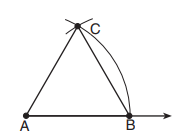Now that I'm caught up with the current New York State Regents exams, I'm revisiting some older ones.
More Regents problems.
Algebra 2/Trigonometry Regents, January 2013
Part I: Each correct answer will receive 2 credits.
21. The quantities p and q vary inversely. If p = 20 when q = -2, and p = x when q = -2x + 2, then x equals
1) -4 and 5
2) 20/19
3) -5 and 4
4) -1/4
Answer: 1) -4 and 5
If p and q vary inversely, then (p)(q) = k or p = kq.
Since k = pq, then k = (20)(-2) = -40
This means that k = (x)(-2x + 2) = 40
-2x2 + 2x = 40
-2x2 + 2x - 40 = 0
x2 - x + 20 = 0
(x - 5)(x + 4) = 0
x = 5 or x = 4
22. What is the solution set of the equation -SQRT(2) sec x = 2, when 0° < x < 360°?
1) {45°, 135°, 225°, 315°}
2) {45°, 315°}
3) {135°, 225°}
4) {225°, 315°}
Answer: 3) {135°, 225°}
Use the Identity sec x = 1 / cos x
-SQRT(2) sec x = 2
sec x = -2 / SQRT(2)
1/cos x = -2 / SQRT(2)
cos x = -SQRT(2) / 2
cos x = -SQRT(2)/2 when x = 135° or 225°.
23. The discriminant of a quadratic equation is 24. The roots are
1) imaginary
2) real, rational, and equal
3) real, rational, and unequal
4) real, irrational, and unequal
Answer: 4) real, irrational, and unequal
When the discriminant is LESS THAN 0, the roots are imaginary. Eliminate Choice (1)
When the discriminant is EQUAL TO 0, the roots are real, rational and equal. Eliminate Choice (2)
When the discriminant is GREATER THAN 0, there are two real unequal roots. If the discriminant is a PERFECT SQUARE, then the roots are rational. But 24 is not a perfect square, so eliminate Choice (3).
The roots of this equation are real, unequal and irrational, which is Choice (4).
24. How many different six-letter arrangements can be made using the
letters of the word “TATTOO”?
1) 60
2) 90
3) 120
4) 720
Answer: 1) 60
The number of ways to rearrange six letters is 6! However, we have to account for repeated letters. There are two Os and three Ts.
So 6! must be divided by 2! and by 3! or
6 * 5 * 4 * 3 * 2 * 1
3 * 2 * 1 * 2 * 1
Canceling common factors leaves 5 * 4 * 3 = 60.
25. Expressed in simplest form, 3y/(2y - 6) + 9/(6 - 2y) is equivalent to
1) (-6y2 + 36y - 54) / ( (2y-6)(6-2y) )
2) (3y - 9)/(2y - 6)
3) 3/2
4) -3/2
Answer: 3) 3/2
Note that the demoninators are opposites. You can reverse the second denominator by multiplying the second fraction by (-1)/(-1). Then the fractions can be combined.
3y/(2y - 6) + (-1/-1) (9/(6 - 2y)
= 3y/(2y - 6) - 9/(2y - 6)
= (3y - 9)/(2y - 6)
After the fractions are combined, you can continue to simplify:
(3y - 9)/(2y - 6) = (3)(y - 3)/( (2)(y - 3) ) = 3/2
More to come. Comments and questions welcome.
More Regents problems.
I also write Fiction!
You can now preorder Devilish And Divine, edited by John L. French and Danielle Ackley-McPhail, which contains (among many, many others) three stories by me, Christopher J. Burke about those above us and from down below.
Preorder the softcover or ebook at Amazon.
|  |
























